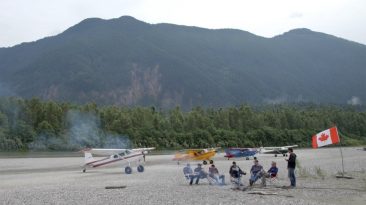Watch in HD – you can read the Panel!
Ride along as I do several circuits (take-offs and landings) through dusk into official night (30 mins after sunset).
Toronto Island Airport – CYTZ – class C control zone.
9 landings in ~45 minutes!
It is a cold February evening, there is a medium cross wind from the north west / right side (I am using runway 26)
This was the first time I had my full multi cam set-up recording intercom and ATC audio, so it is a very watchable flight as I talk through everything I am doing.
It is a great example of the normal circuit procedures in a 172SP, in a control zone.
(This is also the first time I have shot GoPro at night – they preformed well for my needs, but maybe a little noisy for professional broadcast…)
This was a relatively busy night so there was lots of radio work, but ATC was very accommodating allowing me to do a pile of circuits to refresh my night currency.
(In Canada we need to do 5 night landings every 6 months to legally carry passengers at night; I try to do so at least every ~3 months; this is above and beyond day currency – For which insurance requires half an hour logged every 30 days; however, I try to get up about 2-3 times per month.)
My usual style is to cut shorter videos, but this one is pretty action packed, so after reviewing it for my own benefit, I realized it was worth sharing in it’s entirety – the good the bad and the occasional sloppiness.
In all seriousness, for a “weekend warrior” VFR guy, I’m happy with my performance…
Was it perfect? Hell, no. But there were no glaring errors, and I caught most of my minor mistakes as I made them.
I welcome any other constructive criticism and/or positive feedback.
If I get some positive feed back regarding this “little or not edited” format, I’ll consider adding more “Full Flight videos”, but for the most part I think a shorter ~5 minute video format is more “digestible”.
I added some additional voice overs / over lay text, and cut out some of the ground operations so it isn’t boring.
I dare you to watch all ~45 mins! – it is worth it – honest 🙂
If you really want to skip to some of the best parts, here are some hi-light time codes:
Time: 4:55
Short final + a good landing, dusk
Time: 7:00
Turning Downwind 2nd circuit
Time: 8:00
Turning base + Landing clearance
Time: 9:20
Short final + 2nd landing, dusk
Time: 11:20
ATC spacing instructions to follow Dash-8
Time: 13:40
Dash-8 Wake Turbulence clearly visible on the water.
Time: 18:50
Sloppy approach as I was enjoying the view on base…
ATC instructed full stop on this one due to risk of wake from departing Dash-8
Time: 21:15
Official night begins – nice cross wind take-off after a full stop due to wake turbulence ahead.
Time: 24:00
Following a Dash-8, another great example of seeing wake turbulence on the water.
I flew a nice Steep approach.
Time: 25:25
Sloppy final, distracted looking at wake on water, then 1st full dark night landing.
It is pretty good but I didn’t hold it off as long as I had intended to.
Time: 26:55
I accurately predict ATC spacing instructions.
Time: 28:00
downwind, full night, following a Dash-8, I’m clearly enjoying the awesome view!
Time: 29:00
Base leg toward city awesome view of the night city sky line.
Landing clearance, and a pretty good approach, but still fail to hold it off as long as I’d hoped…
Time: 32:00
Clear example of a dark night over water resulting in zero visual reference
– it’s a black hole out there, so instrument flying skills need to be sharp even for VFR night flying.
Time: 33:30
Another awesome view on the base leg.
Time 35:05
I get confused with an ATC traffic advisory (this has to happen at least once per flight 🙂
Time: 35:45
Turning to crosswind leg flying into the “black hole” again.
Time: 38:50
Landing clearance and a pretty steep approach requiring full flaps and a full forward slip to get it down.
The landing turned out rather well, but it may have been a better idea just to go around; however, the glider pilot in me tends to try to save most approaches.
Time: 41:40
Take off after a full stop for the final circuit.
Time: 44:10
ATC spacing instructions to fit in with arriving Dash-8 traffic.
It’s a challenging one as I am following a Dash-8 and have one relatively close behind me,
so I’m feeling a little pressure, and sort of hit the wake of the plane I’m landing behind, so the landing is tricky.
It was a good one to end it on 🙂
___
Huge thanks to all the Supporters on Patreon!
Check our Patreon page to find out how to be part of the Flight Chops Community.
Productions like this wouldn’t be possible without your help!
___




















Add comment